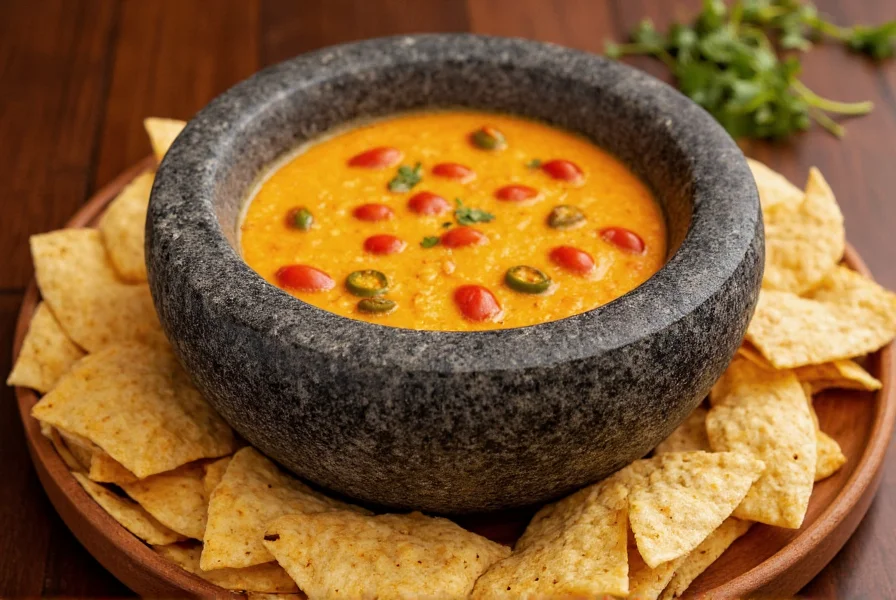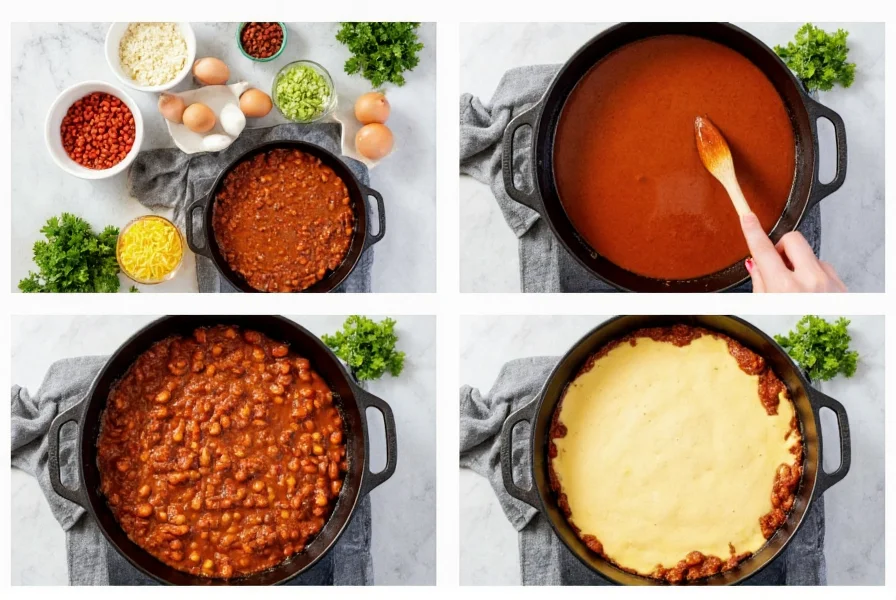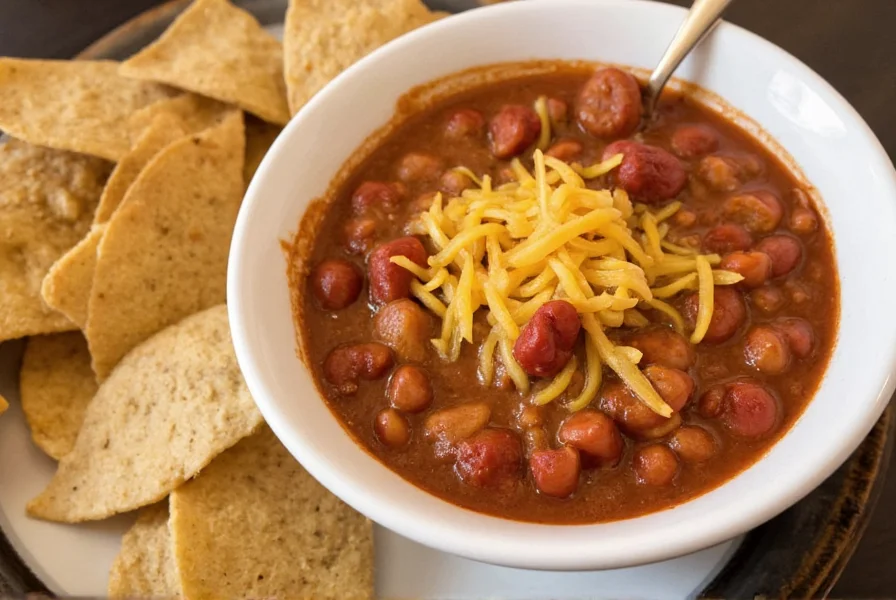When you're searching for what is chili con queso, you're likely looking for more than just a basic definition. This beloved Tex-Mex staple has a rich culinary history and distinct characteristics that set it apart from similar dishes. Let's explore everything you need to know about this creamy, spicy favorite that's become a cornerstone of Southwestern cuisine.
The True Definition of Chili Con Queso
The name "chili con queso" literally translates from Spanish as "chili with cheese." Despite what some might assume from the name, traditional chili con queso doesn't contain chunks of meat like its cousin chili con carne. Instead, it's fundamentally a cheese dip featuring melted cheese blended with chili peppers, tomatoes, and various seasonings.
Authentic versions use fresh queso fresco or blanco cheese, though in many American restaurants and homes, processed cheese products like Velveeta have become popular for their smooth melting properties. The "chili" component comes from various peppers - typically jalapeños, serranos, or canned green chilies - which provide the dish's characteristic heat.

Historical Origins and Cultural Evolution
Chili con queso has roots in the culinary traditions of Northern Mexico and South Texas. The dish evolved from simple cheese preparations used by Mexican settlers who incorporated local ingredients. Historical evidence suggests that cheese-based dips were common in Mexican cuisine long before the term "chili con queso" entered American lexicon.
The modern version popular in the United States gained prominence in the mid-20th century, particularly in Texas. Restaurants like the famous Torchy's Tacos and other Tex-Mex establishments helped popularize the dish, often serving it as an appetizer with tortilla chips. The processed cheese version became especially popular due to its consistent texture and shelf stability.
Key Ingredients in Traditional Chili Con Queso
Understanding what ingredients make authentic chili con queso is essential to appreciating this dish. While recipes vary by region and chef, these components form the foundation:
- Cheese: Queso fresco, queso blanco, or processed cheese like Velveeta
- Chili peppers: Jalapeños, serranos, or canned green chilies
- Liquid component: Milk, beer, or broth to achieve proper consistency
- Tomatoes: Diced tomatoes or tomato sauce for acidity
- Seasonings: Cumin, garlic, onion powder, and sometimes cayenne
| Ingredient Type | Traditional Options | Modern Variations |
|---|---|---|
| Cheese Base | Queso fresco, queso blanco | Velveeta, American cheese |
| Peppers | Fresh jalapeños, serranos | Canned green chilies, chipotle |
| Texture Enhancer | Milk, broth | Beer, evaporated milk |
| Additional Elements | Simple seasonings | Ground beef, beans, corn |
Chili Con Queso vs. Similar Dishes: Clearing Up Confusion
Many people confuse chili con queso with other similar dishes. Understanding these distinctions is crucial when exploring what exactly defines chili con queso:
- Chili con carne: Contains meat (typically beef) and beans, with little to no cheese component
- Queso dip: A more generic term that may not include chili peppers
- Chile con queso: The more linguistically accurate spelling (with 'h' in chile)
- Tex-Mex queso: Often refers to the Americanized version with processed cheese
While some modern recipes incorporate ground beef or other additions, purists maintain that true chili con queso should focus on the cheese and chili components without meat.
Preparation Methods: From Traditional to Contemporary
Learning how to make authentic chili con queso reveals why this dish has endured. Traditional preparation involves:
- Melting cheese slowly over low heat
- Adding finely diced chili peppers
- Incorporating tomatoes and seasonings
- Maintaining proper consistency with liquid
The key challenge in preparation is preventing the cheese from separating or becoming grainy. Traditional cooks use techniques like adding a small amount of cornstarch or evaporated milk to maintain emulsion. Modern versions often rely on processed cheese products that melt smoothly without additional stabilizers.

Regional Variations Across the United States
As chili con queso spread beyond its Tex-Mex origins, regional variations emerged. In what states serve authentic chili con queso, you'll find these distinctive styles:
- Central Texas: Focuses on queso blanco with minimal additions
- South Texas: Often includes ground beef (though not traditional)
- New Mexico: Incorporates local red or green chile varieties
- California: May feature fresher ingredients and artisanal cheeses
- Midwest and East Coast: Typically uses processed cheese versions
These regional differences highlight how chili con queso meaning has evolved across American culinary landscapes while maintaining its core identity as a cheese-based chili dip.
Serving Traditions and Modern Applications
Traditionally served as an appetizer with tortilla chips, chili con queso has expanded into numerous culinary applications. Understanding how to serve authentic chili con queso enhances the experience:
- As a dip with freshly made tortilla chips
- As a sauce for enchiladas or tacos
- Poured over nachos as a premium topping
- As a filling for quesadillas
- Drizzled over grilled meats or vegetables
The dish is best served warm but not piping hot, as excessive heat can cause the cheese to separate. Many restaurants keep it in specialized warming containers to maintain optimal texture and temperature.
Frequently Asked Questions About Chili Con Queso
Does authentic chili con queso contain meat?
No, traditional chili con queso does not contain meat. Despite what some restaurant versions might suggest, authentic chili con queso is a cheese-based dip that focuses on melted cheese and chili peppers. The confusion often arises because "chili" in the name references the peppers, not the meat-containing dish chili con carne.
What's the difference between queso and chili con queso?
Queso is a general Spanish term for cheese, while chili con queso specifically refers to a cheese dip that includes chili peppers. In culinary contexts, "queso" often refers to simple melted cheese dips, while "chili con queso" indicates a more complex preparation with peppers and other seasonings that give it distinctive flavor and heat.
Why is Velveeta commonly used in chili con queso?
Velveeta is commonly used in American-style chili con queso because it melts smoothly without separating, creating a consistent, creamy texture that's difficult to achieve with traditional cheeses. Its sodium citrate content acts as an emulsifier, preventing the cheese from becoming grainy when heated. While not traditional, this processed cheese product has become popular for its reliability in restaurant and home settings.
Is chili con queso Mexican or Tex-Mex?
Chili con queso is considered Tex-Mex rather than traditional Mexican cuisine. While it has roots in Northern Mexican cheese preparations, the specific combination and preparation methods evolved in Texas along the U.S.-Mexico border. Authentic Mexican cuisine typically features simpler cheese preparations without the blended, dip-style consistency characteristic of American chili con queso.
How can I prevent my homemade chili con queso from becoming grainy?
To prevent graininess in homemade chili con queso, melt the cheese slowly over low heat, avoid boiling, and consider adding a small amount of evaporated milk, beer, or cornstarch slurry to help maintain emulsion. Processed cheeses like Velveeta naturally resist separation, but for authentic versions using queso fresco or blanco, maintaining proper temperature control is essential for smooth texture.











 浙公网安备
33010002000092号
浙公网安备
33010002000092号 浙B2-20120091-4
浙B2-20120091-4